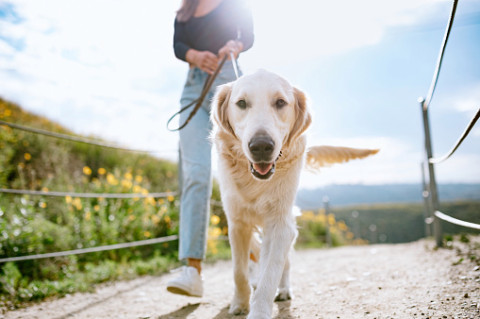When Is Too Hot to Walk Your Dog

Daily dog walking is among the best ways to take care of your pet as it improves its mental and physical health. Nonetheless, walking your dog in adverse weather conditions can be dangerous and harmful to your pet. It can lead to infections that have the potential to kill your lovely pet, yet not walking it at all can make it restless and distressed. Therefore, it is important to understand which temperatures are the best for taking your dog on a stroll. You should also observe certain preventive measures to protect the health of your dog before and after walks. These measures include scheduling to walk your dog in the evening or early mornings when temperatures are cooler and taking good care of it after the walks.
Factors that Affect how Your Dog Handles Heat
 Various factors determine how your dog is affected by different temperatures. Age, breed, size and health are some of these factors. Too old or too young dogs, sick and obese dogs are at a relatively higher risk of heatstroke as explained below.
Various factors determine how your dog is affected by different temperatures. Age, breed, size and health are some of these factors. Too old or too young dogs, sick and obese dogs are at a relatively higher risk of heatstroke as explained below.
Age
Unlike younger dogs, many older dogs find it difficult moving around, more so in hot weather. These dogs are likely to face difficulties trying to move away from the sun, once they find a comfortable spot in the sun, they swiftly fall asleep and end up overheating.
Breed
Different dog breeds handle heat distinctly. Those breeds with long snouts efficiently cool the air as they breathe whereas brachycephalic dogs, those with short snouts such as boxers and pugs, do not cool air well and have difficulty breathing in high temperatures hence more vulnerable to heatstroke.
When is it Too Hot for a Dog?
The risk of dogs getting heatstroke is high in hot weather. However, different show varying tolerance to heat. Some can stand up to 25 degrees Celsius, whereas others can get heatstroke at as low as 16 degrees Celsius, especially obese or flat-faced dogs. The risk of heat damage is lowest between 12 and 15 degrees Celsius for almost all dog breeds, this temperature is safe and enjoyable and dogs can stay outside for as long as they like. Various factors affect the maximum temperature for dog walking, including the intensity of wind and humidity in the atmosphere. Check how hot the pavement is by placing the back of your hand on the pavement and keeping it there for 5 to 10 seconds. Walking your dog on hot pavement for prolonged periods can cause damage to its paws.
When is it Too Cold for a Dog?
Walking your dog in the cold can also cause potential harm if the temperatures are extremely low. Small and medium dogs are safe for up to 4 degrees Celsius, whereas big dogs can walk in as low as 1 degree Celsius. However, be cautious not to keep your dog in the cold for too long, 20 to 30 minutes is enough.
Dangers of Heat to Your Dog
Excessive elevation of your dog’s body temperature can lead to a condition known as hyperthermia or heat stroke. The symptoms that your dog may be the victim of heatstroke include heavy panting, thick saliva and dark red gums. Heatstroke can harm your dog’s internal organs, and hot pavements can burn your paws.
What To Do if Your Dog Shows Signs of Heatstroke
If your dog exhibits heatstroke symptoms, first move it to a cool area with no direct sunlight and give it drinking water. Run cold water over it or place a wet towel on them. Seek immediate assistance from a veterinarian.
Safety Tips for Walking your Dog in Hot Weather
There are some precautions you can practice when walking your dog in summer to minimize the risk of hyperthermia. They include:
- Do not abandon it in the car. Temperatures can increase to hazardous levels inside a car, and this can cause severe organ damage that can potentially kill your pet.
- Watch the humidity levels, not just temperature. Dogs cool down by evaporating moisture from their bodies, and in high humidity this is made difficult, increasing their body temperatures.
- Shifting your dog-walking schedule to cooler hours of the day. Temperatures are usually low in the mornings and evenings due to less direct sunlight, these can be good periods to walk your dog.
- Always have a bottle of water when waking your dog. High temperatures cause dehydration, and a bottle of water can keep your dog rehydrated and make the walk bearable.